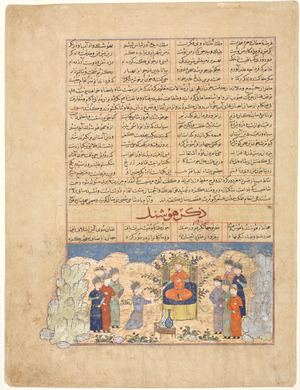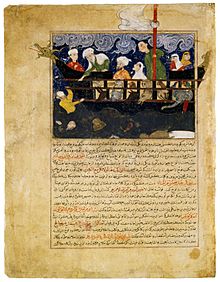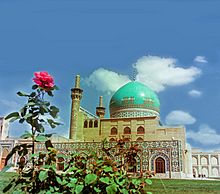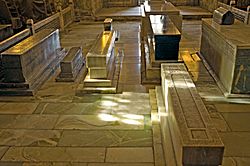Shah Rukh facts for kids
Quick facts for kids Shah Rukh |
|||||
|---|---|---|---|---|---|
| Sultan, Padshah, Bahadur | |||||
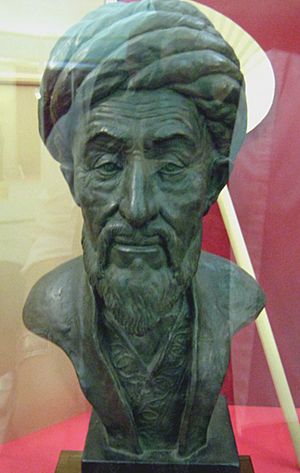
Forensic facial reconstruction
|
|||||
| Ruler of the Timurid Empire | |||||
| Reign | 20 February 1405 – 13 March 1447 | ||||
| Predecessor | Timur | ||||
| Successor | Ulugh Beg | ||||
| Born | 20 August 1377 Samarkand, Timurid Empire |
||||
| Died | 13 March 1447 (aged 69) Rayy, Timurid Empire |
||||
| Burial | Gur-e-Amir, Samarkand, Uzbekistan | ||||
| Consort | Gawhar Shad | ||||
| Wives |
|
||||
| Issue |
|
||||
|
|||||
| Dynasty | Timurid | ||||
| Father | Timur | ||||
| Mother | Taghay Tarkhan Agha | ||||
| Religion | Sunni Islam | ||||
Shah Rukh (also known as Shahrukh Mirza) was a powerful ruler of the Timurid Empire. He ruled from 1405 to 1447. Shah Rukh was the son of the famous conqueror Timur (also called Tamerlane). Timur founded the Timurid dynasty in 1370.
Shah Rukh mainly ruled the eastern part of his father's empire. This area included much of Persia and Transoxiana. Even though some western lands were lost, Shah Rukh's empire stayed strong. It was a major power in Asia during his time.
He controlled important trade routes between Asia and Europe. This included the famous Silk Road. Because of this, Shah Rukh became very wealthy. He chose Herat as his capital, not Samarqand like his father. Herat became the main political center of the Timurid Empire. Both cities grew rich and important under his rule.
Shah Rukh was a big supporter of arts and sciences. These areas thrived during his reign. He focused on keeping his lands stable and peaceful. He also worked to maintain good relationships with nearby kingdoms. Historians say Shah Rukh was a very religious and modest ruler. He helped repair much of the damage caused by his father's conquests.
Contents
Early Life of Shah Rukh
Shah Rukh was born on August 20, 1377. He was the youngest of Timur's four sons. His name has interesting meanings in Persian. Shah means "king" or "the best." Rokh means "face" or "rook" in chess. It also refers to the chess move called "castling."
According to one historian, Timur was playing chess when Shah Rukh was born. He named his new son after the "castling" move. Shah Rukh's mother was Taghay Tarkhan Agha, a concubine of Timur's. However, he was raised by Saray Mulk, Timur's chief wife.
Shah Rukh During Timur's Reign
Timur and Shah Rukh did not seem to have a very close relationship. Shah Rukh never upset his father. In 1397, Timur made Shah Rukh governor of Khorasan. His capital was Herat. This was an important region. However, it was the same position his older brother had held at a younger age. Shah Rukh was not promoted further while his father was alive.
Some historians think Timur might not have favored Shah Rukh because his mother was a concubine. Others suggest Timur felt Shah Rukh lacked the qualities needed to rule. Shah Rukh was known for being very modest and religious. His strong Islamic beliefs, which differed from Timur's respect for Genghis Khan's laws, might have also caused a rift.
Shah Rukh joined Timur's campaign against the Ottoman Empire. This led to the Battle of Ankara in 1402. Shah Rukh led the left side of the army. The battle was a big victory for Timur. The Ottoman Sultan, Bayezid I, was captured.
Struggle for the Throne
Timur died in 1405 while planning a campaign against China. He had not clearly named an heir. This led to a fight for power among his sons and grandsons. Khalil Sultan, a grandson, declared himself emperor in Tashkent. He took the royal treasury and Timur's capital, Samarqand.
Shah Rukh marched his army towards the Oxus river. But he did not attack Khalil Sultan right away. Khalil Sultan's father, Miran Shah, was a threat. Miran Shah and his other son, Abu Bakr, were bringing an army from Azerbaijan. However, they had to turn back due to other invasions. Miran Shah died in battle in 1408. Abu Bakr died the next year.
For several years, Shah Rukh and Khalil Sultan had talks and battles. Khalil Sultan often won. Other relatives also tried to claim the throne. These included Sultan Husayn Tayichiud, another grandson of Timur. Sultan Husayn was later defeated and executed by Shah Rukh. Two more grandsons, Iskandar and Pir Muhammad, also fought for power. Shah Rukh defeated Iskandar, and Khalil Sultan defeated Pir Muhammad. Pir Muhammad was killed by one of his own nobles in 1407. Iskandar was executed in 1415 after another rebellion.
The war began to turn in Shah Rukh's favor in 1409. Khalil Sultan started losing support in Samarqand. His wife, Shadi Mulk, had too much power. She gave important jobs to low-ranking people instead of Timur's old nobles. Also, some of Timur's widows were forced to marry men of no importance.
A famine caused more unhappiness among the people. Khalil Sultan was captured by a powerful leader named Khudaidad Hussain. Hussain took Khalil Sultan to Ferghana. Shah Rukh then took Samarqand without a fight. Khalil Sultan had to submit to Shah Rukh. He was made governor of Rayy but died in 1411.
After these deaths, Shah Rukh had no major rivals. He began his reign as Timur's true successor. He ruled from Herat, not Samarqand. Samarqand was given to his eldest son, Ulugh Beg, as governor of Transoxiana.
Military Actions and Campaigns
Battles with the Qara Qoyunlu
Shah Rukh began his rule by taking back regions that had broken away. He took Fars in 1414. Two years later, Kirman was also brought under his control. Shah Rukh's empire continued to grow. By 1420, he ruled the eastern part of Timur's empire. He also controlled central and southern Persia.
However, the western part of the empire was still outside his control. This area included Azerbaijan and Mesopotamia. These lands were held by Qara Yusuf of the Qara Qoyunlu (Black Sheep Turkoman). Qara Yusuf had killed Shah Rukh's brother, Miran Shah. The Qara Qoyunlu had taken cities like Baghdad and Tabriz. They were a dangerous neighbor to the Timurids.
Shah Rukh tried many times to secure his western border. He launched three campaigns against Azerbaijan. None of them fully succeeded. Qara Yusuf died during the first campaign in 1420. This led to the Timurids taking Azerbaijan and Armenia.
But less than a year later, Qara Yusuf's sons rebelled. One son, Qara Iskander, tried to regain Turkoman control. This led to the second campaign in 1429. Shah Rukh won again. He put another Qara Qoyunlu prince, Abu Said, in charge as a puppet ruler. But Qara Iskander took Tabriz back two years later. He also had Abu Said executed.
This led to the third and final campaign in 1434. Qara Iskander was forced to flee again. He was later killed by his own son. This campaign did not completely solve the Turkoman problem. However, it brought stability to the region for the rest of Shah Rukh's rule. He put Qara Iskander's less aggressive brother, Jahan Shah, in power.
Dealing with Hurufis and Intellectuals
The Hurufis were a Sufi group. They believed in the mystical meaning of letters. In the late 1300s, they were accused of being heretics. Their founder, Fazlallah Astarabadi, was executed by Timur's son in 1394. Because of this, the Hurufis hated the Timurids.
In 1426, Shah Rukh was attacked while leaving a mosque. He recovered quickly. An investigation linked the attacker to the Hurufis and Astarabadi's family. There was an immediate reaction against the group. Astarabadi's grandson was executed. Important members of the group were questioned.
These questions went beyond the Hurufis. Many thinkers in Herat had to defend themselves against accusations of blasphemy. This included the historian Sharaf al-Din Ali Yazdi. The poet Qasem-e Anvar was forced to leave the capital. Even a famous calligrapher, Ma'ruf-i Khattat, was arrested.
It is not fully clear how involved the Hurufis were in the attack. However, these events made relations worse between the Timurid court and the empire's intellectuals.
Family Rebellions
Early in his reign, Shah Rukh often moved his relatives to different governorships. He hoped this would prevent them from rebelling. For example, Khalil Sultan was moved from Samarqand to Rayy.
But these efforts did not fully work. Shah Rukh had to put down many rebellions by his family members. Iskandar Mirza rebelled in 1413 and damaged cities like Isfahan. Bayqara also rebelled in Shiraz. These uprisings continued even when Shah Rukh was old. In 1446, at nearly seventy years old, he had to fight his grandson Sultan Muhammad. Sultan Muhammad had rebelled in the western provinces.
How Shah Rukh Ruled
Shah Rukh's reign saw big improvements in the economy and culture. This was partly due to his more diplomatic nature compared to Timur. However, other influences also helped his rule succeed. His wife, Gawhar Shad, and his sons helped keep the government running smoothly.
Some of his top officials were very talented. They stayed in their jobs for many decades. These included Jalal-ud-din Firuz Shah, who led the army for 35 years. Ghiyath al-Din Pir Ahmad Khvafi was the supreme secretary for 31 years. Amir Alika Kokultash managed state finances for 43 years.
Shah Rukh changed some of Timur's policies. He placed less importance on Mongol ideas of authority. He removed the Mongol courts and replaced them with Sharia (Islamic law) courts. Shah Rukh did not use Timur's title of Amir. Instead, he used the Islamic titles of Sultan and Padshah.
His religious advisor, Jalal-Din al-Qayini, described these changes in 1411. He said Shah Rukh abolished the yarghu court. This court followed old Turko-Mongolian customs. Another writer, Sain ad-Din Ali Turka Isfahani, praised Shah Rukh. He said everyone with a legal case was heard according to Islamic law.
Cultural Achievements
Shah Rukh's wife, Gawhar Shad, paid for two mosques and colleges. These were built in Mashhad and Herat. The Gawhar Shad Mosque was finished in 1418. The ruling family had mixed backgrounds. This led to a unique culture. It combined Persian art and civilization with ideas from China. Literature was written in Persian, Chagatay, and Arabic.
Shah Rukh ordered many historical and geographic books. These were written by Hafiz-i Abru. One important work was Tāriḵ-e Šāhroḵ(i). This book covered Shah Rukh's reign up to 1414. It was later included in larger history collections.
International Relations
During Shah Rukh's rule, relations with Ming China improved. This was different from Timur's time, when war almost broke out. Chinese envoys visited Samarqand and Herat several times. A large embassy from Shah Rukh traveled to Beijing from 1419 to 1422. They were welcomed with big feasts and gifts. Shah Rukh sent letters to the Yongle Emperor. He invited him to Islam and praised Islamic law. These letters also showed that the Timurids were independent, not vassals of China.
Shah Rukh also had good relations with other rulers. Monarchs from the Aq Qoyunlu, India, and the Ottoman Empire paid respect to him. The Sultans of Delhi exchanged envoys with Shah Rukh. They swore loyalty to him. The Sultan of Bengal even asked for his military help.
Relations with the Mamluks of Egypt were tense at first. Shah Rukh tried to show his power. But relations became normal when Sultan Jaqmaq took power. The two rulers were friendly and treated each other as equals.
Death and Succession
Shah Rukh died in March 1447 in Rayy. He was nearly seventy years old and in poor health. He had just put down a revolt by his grandson, Sultan Muhammad. News of his death spread quickly. Chaos broke out in the army camp. It was impossible to move his body to the capital for burial right away.
After three days, his body began its journey east. It was with his wife, Gawhar Shad, and his grandson, Abdal-Latif. However, Abdal-Latif took his grandmother and Shah Rukh's body hostage. He might have wanted to claim the throne for himself or his father, Ulugh Beg. Another grandson, Ala al-Dawla, defeated Abdal-Latif's troops. He freed Gawhar Shad. Shah Rukh was then buried in the Gawhar Shad Mausoleum in Herat.
When Ulugh Beg captured Herat the next year, he ordered his father's body to be moved. Shah Rukh was reburied next to Timur in the Gur-e-Amir in Samarqand. The fight for the throne continued for several years among Shah Rukh's family. Ulugh Beg won at first. But he was murdered by his son Abdal-Latif in 1449. After more civil wars, Shah Rukh's descendants lost control of the Timurid Empire.
Family Life
Wives
- Gawhar Shad, daughter of Ghiyas-ud-din Tarkhan
- Malikat Agha, daughter of Khizr Ughlan Chaghatay, widow of Umar Shaikh Mirza I
- Tuti Agha, a Narin Mughal lady
- Aq Sultan Agha, daughter of Charkas bin Timan Ilchigiday
- Mihr Nigar Agha, an Uzbek Bisut lady
- La'l Takin Agha
Sons
- Ulugh Beg (1394–1449) – with Gawhar Shad Begum. He was the ruler of Transoxiana and later became emperor.
- Sultan Ibrahim Mirza (1394–1435). He was the ruler of Persia.
- Baysunghur (1397–1433) – with Gawhar Shad Begum. He was an artistic son who played a role in his father's government.
- Soyurghatmish Mirza (1399–1426) – with Malikat Agha. He was the ruler of India and Ghazni.
- Muhammad Juki Mirza (1402–1444) – with Gawhar Shad Begum. He was the ruler of Garmsir and Khuttal.
Daughters
- Maryam Sultan Agha (died 1441) – with Gawhar Shad Begum. She married Muhammad Jahangir Mirza.
- Qutlugh Turkan Agha – with Gawhar Shad Begum
- Qutlugh Sultan Agha – with Tuti Agha
- Taghay Turkan Agha – with Tuti Agha
- Sa'adat Sultan Agha – with Gawhar Shad Begum
- Payanda Sultan Agha – with Aq Sultan Agha. She married Yahya Mirza.
Facial Reconstruction
A Soviet scientist named Mikhail Mikhaylovich Gerasimov recreated the faces of Timur, Shah Rukh, and Ulugh Beg. Timur looked more like people from East Asia. Shah Rukh, whose mother was Tajik, had more European-like features. Shah Rukh's son, Ulugh Beg, mostly had features like people from Mongolia.
See also
 In Spanish: Shahruj para niños
In Spanish: Shahruj para niños
- Ahmed Lur
- Miraj Nameh


